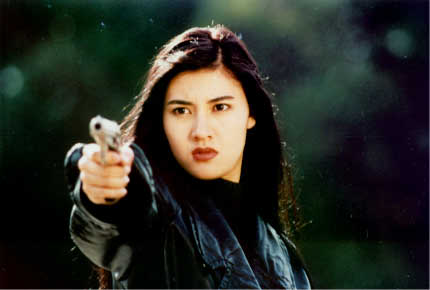
Feminist Readings

The superficially progressive foregrounding
of women in so many action roles in HK cinema is immediately subject to
two obvious constraints. The first involves the prominence of recuperative
narratives that re-inscribe women into the patriarchal order through narrative
closure involving conventions of romance or re-assertion of patriarchal
power. The second concerns the social construction of gender itself.
According to this view, the prominence of women wielding symbols of power
and authority (such as guns) in conspicuously individualistic, competitive
ways within narratives predominantly identified as supporting patriarchal
ideology simply identifies them with that ideology. Merely changing
the gender of the principal protagonist(s) in muscle dramas without changing
other gender signifiers essentially leaves the patriarchal text intact.
This masculine genre is further supported by the male “look,” comprising
elements of objectifying, fragmenting or fetishizing the female body, within
a voyeuristic context that has been characterized by Laura Mulvey as involving
a “sadistic” male gaze (Note 9).
Many HK action films do, indeed, involve prominent elements of costuming,
female suffering at the hands of men, and graphic sexuality. In many
instances the gender and sexuality of a powerful female protagonist is
questioned. Authority roles are typically associated with absence
of sexual expression. The patriarchal frame of delegated male authority
seems almost universal.
9. Mulvey, op. cit.